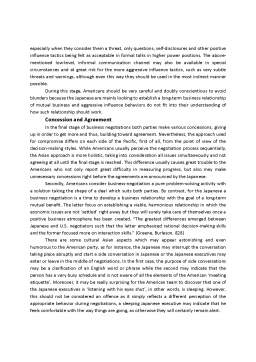Extras din referat
“When the American executive travels abroad to do business, he is frequently shocked to discover to what extent the many variables of foreign behaviour and custom complicate his efforts”. (Hall 87)
The most difficult part of an international business negotiation is the actual conduct of the face-to-face meeting. Even though the best representatives may have been chosen and they may be very well-prepared, things can still go wrong during the negotiation process since this is almost always the greatest challenge Americans face when seeking to do business with Japanese.
Both countries follow a four-stage sequence in business negotiations: (1) non-task sounding, (2) task-related exchange of information, (3) persuasion, (4) concessions and agreement. However, major difficulties in any cross-cultural business negotiation spring from the differences between the cultures with respect to the importance of and time spent on each stage.
The present paper explores thoroughly the above-mentioned stages of the business negotiation process outlining the cultural discrepancies that seriously influence it starting with a brief presentation of each stage.
The first stage, the non-task sounding stage does not include any information about the business, the parties only seeking to establish a rapport by getting to know one another. The second stage involves an exchange of information between the parties regarding their needs and preferences, or, “stated more precisely, the parties’ subjective expected utilities of the various alternatives open to the interactants.” (Ghauri, Usunier 394) In the third stage, the one of persuasion, the parties attempt to modify one another’s perspective on the business by using various persuasive tactics. The final stage brings up with it the consummation of an agreement after a series of concessions and other smaller agreements.
“Despite the consistency of this process across cultures, the content and duration of each stage differ substantially between the two cultural groups.” (Ghauri, Usunier 394) For instance, the first stage is very short for the Americans as compared with the Japanese, since the former spend little time establishing a rapport, while the latter make a great effort in the beginning to create a harmonious relationship by a series of non-task interactions and even ceremonial gift giving.
“The key to a successful negotiation is to be trusted and evaluated as a dependable person. This necessitates socializing a number of times. Japanese feel rushed and threatened when they are not given enough time to learn about their own negotiating counterparts. This includes learning to read the others’ emotions and emotional states as well as learning how to differentiate between hone and tatemae.” (Alston, Takei 105)
The second stage is perceived by the Japanese as the most important part since the exchange of information and a deep understanding of the associated details are considered imperative. They are renowned for their seemingly ‘endless’ questions while offering only little information and ambiguous answers. On the other hand, Americans are more into direct, clear statements of needs and preferences, at this stage, wishing to spend more time in the third stage of negotiation, persuasion. They use different tactics of persuasion, often aggressive ones, openly disagreeing and offering alternatives, a way of behaving very different from that of the Japanese who avoid arguments by changing the subject, keeping silent for a while or even withdrawing. As for the final stage, while Americans tend to make concessions throughout the process, the final agreement being only a sequence of several smaller concessions, the Japanese tend to make concessions at the end of the negotiation, the agreement being concluded rather abruptly from the Americans point of view. “Such differences are a major point in procedural conflict for trans-Pacific negotiation” (Hodgson, Graham, Sano 108)
Non-Task Sounding
Establishing a business relationship in the United States typically starts with a letter of introduction, followed by a phone call for appointment, then a meeting at the client’s office and perhaps lunch. At the negotiations table, Americans always start by discussing topics other than business five to ten minutes. Thus, they may speak about the weather, family, sports, politics, or business conditions in general trying to learn as much as possible about the other side, and at the same time making judgments about his/her degree of trustworthiness, position in the company, or mood that day.
“While some pre-negotiation information can be exchanged via mail and faxes important information is delivered personally because face-to-face communication is best when dealing with Japanese”. (Alston, Takei 104) Therefore, the typical Japanese business routine would start with an appointment set up and attended by a shokai-sha, a third-party introducer, and then the Japanese party will invite both the American client and the shokai-sha at the Japanese firm’s offices usually late in the afternoon. “There, the Americans will meet the concerned operational-level personnel for a “chat”, not to include business talk or proposals.” (Ghauri, Usunier, 396)
Preview document
Conținut arhivă zip
- Business Negotiations between Japanese and Americans.doc












